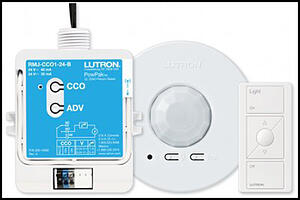 If you’re responsible for the design, specification or installation of commercial or residential lighting systems, you know that your customers are increasingly thinking “outside the box” when it comes to solutions for their homes and businesses. Nobody, it seems, is content to simply “turn on the lights.”
If you’re responsible for the design, specification or installation of commercial or residential lighting systems, you know that your customers are increasingly thinking “outside the box” when it comes to solutions for their homes and businesses. Nobody, it seems, is content to simply “turn on the lights.”
Commercial and residential clients alike want solutions that offer more than illumination. They want solutions that automatically control lighting, window coverings and heating/cooling systems. And they’re after more than simple automation. They want to create environments that are more comfortable and more conducive to productivity. And they also want energy efficiency that is easier on the environment—and on their wallets.
That means if you want to meet your customers’ needs—whether they are commercial or residential customers—you need to provide “out-of-the-box” solutions that push the boundaries of conventional light and energy systems. But doing that will also require some “inside-the-box” thinking, because inside the “box” is where you’ll find the item that drives a lot of this capability: sensors.
It may seem obvious, but lights and window coverings and heating/cooling systems that automatically adjust still need something to tell them when to make an adjustment. It used to be: “Last one out, please turn off the lights!” Now the last one out turns off the lights (opens or closes the shades, and turns down the heat) without lifting a finger. And that’s a good thing, because people are notoriously bad at remembering to do those things—resulting in a lot of wasted energy.
Sensors can now track usage of rooms and automatically adjust the environment of the room according to need. Even if your customers forget to turn off the lights, the sensors in the systems you install for them won’t forget.
What’s really great for individuals in our industry (and of course, their customers) is that sensors today are more reliable—and affordable—than ever. And, yet, despite that, there is still a huge opportunity for both commercial and residential installation.
It’s not surprising that Lutron is leading the way in incorporating sensors into their lighting and energy control systems. They are even offering a Sensor Layout and Tuning Service to ensure that their wired or wireless daylight sensors and occupancy sensors will help projects achieve energy-savings goals. They even provide a detailed sensor layout for the installing contractor to use. And the service also includes up to two visits after installation to adjust the system for optimal results.
Are you thinking both “inside-and-outside-the-box” when it comes to lighting and energy controls for your customers? Are you taking advantage of the opportunities that sensors create to deliver the kind of systems your clients want?
If you’d like more information about incorporating sensors in commercial solutions, shoot Matt Sedlock a note. If you’re interested in residential solutions, send a note to me, Jimm Reifsnyder.
